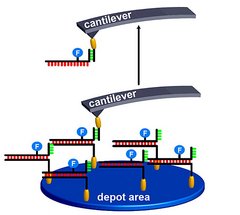Monday, 01 February, 2010
Fluorescence Microscopy goes High Definition
New dye probes enhance microscopic resolution and thus allow for more detailed insights into the interior structure of individual cells.
Scientists frequently use fluorescent probes to decode the structure of individual cells. These dyes attach themselves to specific molecules within the cell and, after being stimulated by laser light, emit fluorescent radiation. A microscope moves across the sample in minute steps and digitally records all fluorescence signals. The marked molecules are also being recorded, and the signals can be pieced together to form an overall image. However, the current equipment does not render an optimal resolution, since a laser beam has a radius of approximately two hundred nanometers. Therefore it excites several adjacent probes at the same time, and their fluorescence overlaps. Researchers affiliated with physicist Professor Philip Tinnefeld from the Ludwig Maximilian's University of Munich have now presented an elegant solution to this problem. They have developed probes which are surrounded by a type of molecule which absorbs the stimulation output to a certain degree. This shielding prevents the probe molecule itself from fluorescing. Only the core of the laser beam delivers sufficient power to exhaust the capacity of the acceptor molecules and causes the probe to fluoresce. This prevents an overlay of fluorescence from adjacent probes and allows for an exact localization of the individual probes. Thus scientists obtain increasingly detailed insights into the interior structure of individual cells. (Nanoletters online, January 2010)
Press information LMU (english)
Presseinformation der LMU (deutsch)
Publication: "Resolving Single-Molecule Assembled Patterns with Superresolution Blink-Microscopy"


